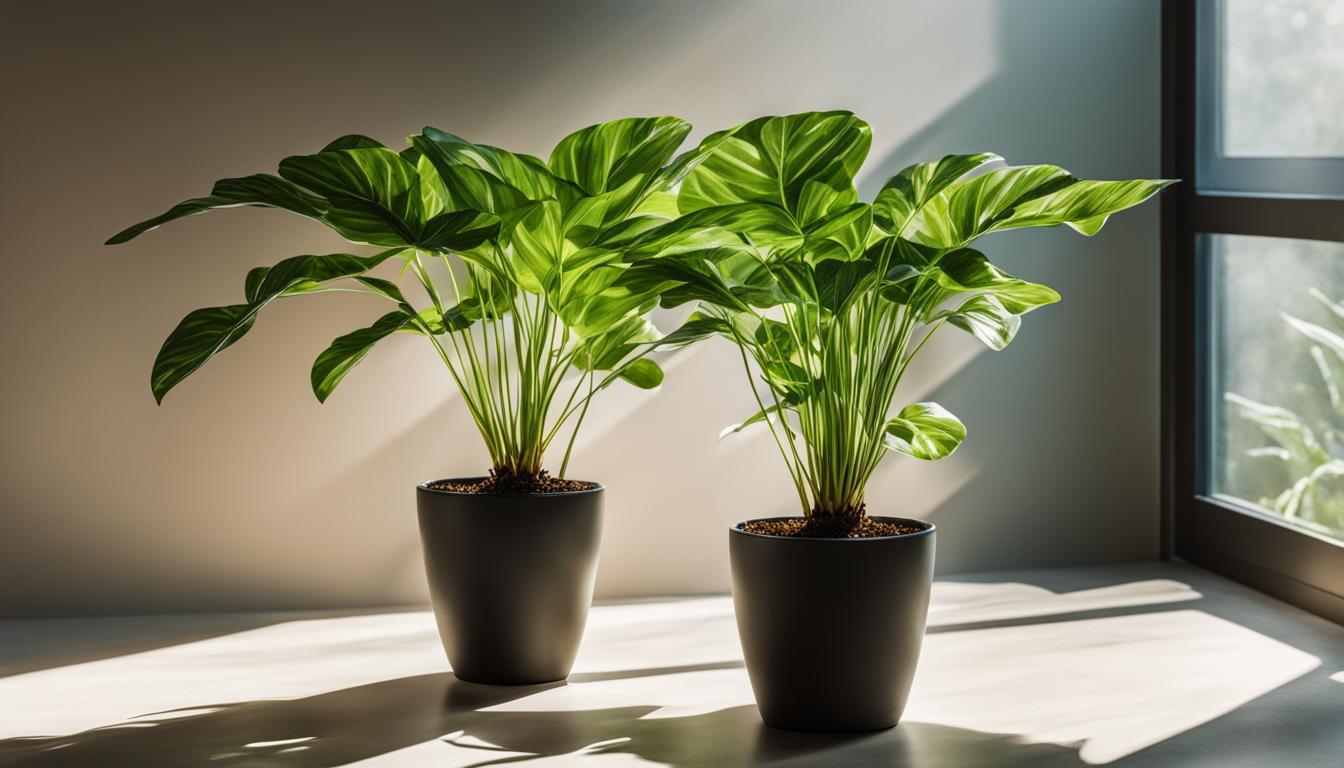
Indoor plants add beauty and freshness to any space, but to ensure their longevity, proper care is essential. By following a few simple tips, you can keep your indoor plants thriving and healthy.
In this article, I will share expert indoor gardening tips and techniques to promote the longevity of your beloved plants.
Key Takeaways:
- Regularly assess your indoor plants’ needs and adjust your care routine accordingly.
- Provide suitable locations with the right lighting, watering, and ventilation for optimal growth.
- Ensure proper watering practices to prevent under or overwatering.
- Control humidity levels to create an ideal environment for indoor plants.
- Maintain consistent temperature and air circulation to avoid stress on the plants.
The Importance of Suitable Indoor Locations for Plant Growth
Creating a suitable environment is crucial for the optimal growth of indoor plants. By providing the right conditions, such as adequate lighting, proper watering, good ventilation, and suitable indoor locations, you can promote the longevity of your plants and ensure their well-being.
Lighting: Indoor plants require different levels of light intensity depending on their species. Some plants thrive in bright, indirect light, while others prefer low light conditions. It’s important to place your plants in areas where they can receive the right amount of light for their specific needs.
Consider factors like natural light availability, the placement of windows, and the use of artificial lighting, such as grow lights, to supplement inadequate light sources.
Watering: Watering practices play a crucial role in plant growth and longevity. It’s essential to water your indoor plants appropriately, taking into account factors such as the plant’s water requirements, the moisture level of the soil, and the climate of your indoor environment.
Overwatering or underwatering can lead to root rot or dehydration, respectively, so it’s important to find a balance and water your plants when the top inch of soil feels dry.
The Importance of Ventilation
Ventilation: Good air circulation is vital for the health of indoor plants. Proper ventilation helps to prevent the buildup of stagnant air, which can create a favorable environment for pests and diseases.
Ensure that the area where your plants are located has adequate airflow by using fans, opening windows periodically, or placing them in rooms with natural air movement.
Choosing Suitable Indoor Locations: Different plants have different preferences when it comes to temperature, humidity, and airflow. It’s important to place your indoor plants in areas that meet their specific needs.
Consider factors such as temperature fluctuations, drafts, and the presence of heating or cooling sources. Avoid placing plants near vents or in areas with extreme temperature changes, as this can stress the plants and hinder their growth.
By understanding the importance of suitable indoor locations for plant growth and implementing the necessary measures, you can create an environment that promotes the longevity and well-being of your indoor plants.
The Role of Proper Watering in Indoor Plant Longevity
Proper watering practices play a crucial role in ensuring the longevity of indoor plants. Understanding the right moisture level and avoiding waterlogging are key to maintaining healthy and thriving plants.
By following some simple guidelines, you can provide your indoor plants with the optimal amount of water they need while avoiding potential damage from overwatering or underwatering.
Firstly, it is important to regularly check the moisture level of the soil. This can be done by inserting your finger about an inch into the soil. If it feels dry at that depth, it’s a sign that the plant needs watering.
On the other hand, if the soil feels excessively wet or waterlogged, it is best to hold off on watering until the top inch of soil dries out a bit.
Watering Frequency and Quantity
The frequency and quantity of watering depend on various factors such as the type of plant, the size of the pot, and the environmental conditions. Some plants require more frequent watering, while others can withstand longer periods between waterings.
It’s essential to research the specific watering needs of your indoor plants to provide them with the care they require. A general rule of thumb is to water deeply until it starts to drain out of the bottom of the pot, ensuring all the roots receive adequate moisture.
Avoiding Waterlogging and Drainage
Waterlogging, which occurs when excess water accumulates in the soil, can lead to root rot and other issues that can shorten the lifespan of indoor plants.
To prevent waterlogging, ensure that your plant pots have proper drainage holes to allow excess water to escape. It’s also advisable to use well-draining potting soil that allows water to flow freely through the roots.
By following these watering practices and paying attention to the moisture level, you can promote the longevity of your indoor plants and ensure their overall health and vitality.
Enhancing Indoor Plant Longevity through Humidity Control
Indoor plants often struggle to thrive in environments with low humidity levels. The dry air can lead to wilting leaves, stunted growth, and increased susceptibility to pests and diseases.
To promote the longevity of your indoor plants, it is crucial to implement effective humidity control measures.
One simple method to increase humidity is misting. Fill a spray bottle with water and mist the leaves of your plants regularly. This helps create a humid microclimate around the plants, providing them with the moisture they need. Alternatively, you can use a humidifier to maintain a constant level of humidity in the room.
Grouping plants together is another effective way to enhance humidity. As plants transpire, they release moisture into the air. By placing multiple plants in close proximity, you can create a collective humid environment. This technique is particularly beneficial for moisture-loving plants, such as ferns and orchids.
Remember to monitor the humidity levels regularly using a hygrometer. Aim for a humidity range of 40-60% for most indoor plants. If the humidity is too low, consider implementing one or more of these humidity control methods to ensure the longevity and vitality of your indoor plants.
Temperature and Air Circulation for Indoor Plant Longevity
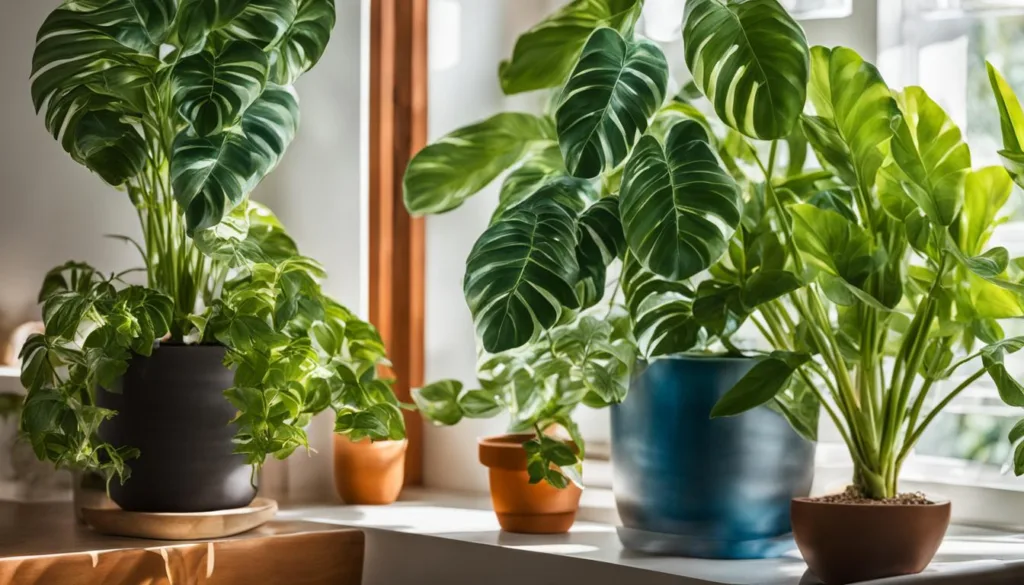
Proper temperature and adequate air circulation are crucial factors in maintaining the longevity of indoor plants. The temperature in your indoor space plays a significant role in plant growth and overall health.
It is essential to avoid placing plants near drafts, heating vents, or air conditioning units, as these can cause rapid temperature fluctuations that can harm plants. A stable temperature range of 65-75°F (18-24°C) is generally suitable for most indoor plants.
Adequate air circulation is also vital for the well-being of indoor plants. Stagnant air can lead to a buildup of moisture, which can promote the growth of fungal diseases and attract pests.
To ensure proper air circulation, avoid overcrowding plants and consider using a fan to gently circulate the air around them. This will help prevent any stagnant pockets of air and create a healthier environment for your indoor plants.
To summarize, maintaining a consistent and suitable temperature range and promoting adequate air circulation are essential for the longevity of indoor plants.
By creating a draft-free environment with proper air movement, you can provide optimal growing conditions and help your plants thrive.
The Impact of Temperature on Indoor Plants
The temperature in your indoor space can have a significant impact on the growth and development of your indoor plants. Extreme fluctuations or consistently high or low temperatures can stress plants and affect their overall health and longevity. When it comes to temperature, consistency is key.
- High temperatures: Excessive heat can cause wilting, leaf burn, and increased water loss through evaporation. It can also make plants more vulnerable to pests and diseases.
- Low temperatures: Cold drafts or chilly conditions can lead to stunted growth, leaf discoloration, and even plant death in extreme cases.
By maintaining a stable temperature within the recommended range and protecting plants from temperature extremes, you can help ensure their longevity and keep them thriving.
| Temperature Tips | Air Circulation Tips |
|---|---|
| – Keep indoor temperatures consistent and within the recommended range. | – Avoid overcrowding plants to allow for proper airflow. |
| – Protect plants from extreme temperature fluctuations or drafts. | – Use a fan to gently circulate the air around plants. |
| – Monitor the temperature in different areas of your indoor space to identify any variations. | – Open windows or use exhaust fans to improve air circulation. |
| – Consider using a thermometer to accurately measure indoor temperatures. | – Regularly clean and remove debris from plant leaves to enhance air circulation. |
The Role of Fertilizing in Promoting Indoor Plant Longevity
Proper fertilizing is a key factor in ensuring the longevity of indoor plants. Fertilizers provide essential nutrients that may be lacking in the soil, promoting healthy growth and overall plant health. Using a balanced fertilizer specifically formulated for indoor plants during the growing season can supply the necessary nutrients for optimal development.
It is important to follow the instructions on the fertilizer package to determine the appropriate dosage and frequency of application.
Over-fertilizing can harm plants, so it is crucial to avoid applying more than the recommended amount. During the dormant period, when indoor plants experience slower growth, it is advisable to reduce or suspend fertilization to prevent nutrient buildup in the soil.
A balanced fertilizer typically contains a mixture of nitrogen (N), phosphorus (P), and potassium (K) in varying ratios. These essential nutrients support different aspects of plant health.
Nitrogen promotes leaf and stem development, phosphorus encourages root growth and flower production, while potassium aids in overall plant vitality and disease resistance.
By providing these nutrients in the right proportions, indoor plants can thrive and remain healthy for a longer period.
Benefits of Using a Balanced Fertilizer:
- Promotes vigorous growth and vibrant foliage
- Enhances overall plant health and resilience
- Supports flower production and fruiting in certain species
- Aids in the prevention of nutrient deficiencies
- Improves the plant’s ability to withstand environmental stressors
Regular fertilization, along with proper watering, lighting, and other care practices, can contribute to the longevity of indoor plants. By understanding the role of fertilizing and providing the necessary nutrients, you can help your indoor plants thrive and enjoy their beauty for years to come.
Pruning and Grooming for Indoor Plant Longevity
Proper pruning and grooming practices play a vital role in maintaining the health and longevity of indoor plants. By regularly tending to your plants’ needs, you can ensure they stay vibrant and attractive. Here are some essential tips and techniques for effective pruning and grooming:
- Remove dead leaves: Dead leaves not only detract from the appearance of your indoor plants but can also harbor pests and diseases. Carefully inspect your plants and gently remove any wilted or yellowed leaves.
- Trim overgrown branches: Over time, indoor plants may develop long, leggy branches that can affect their overall appearance and growth. Pruning these overgrown branches helps maintain a compact and bushy shape, promoting healthy growth.
- Clean the leaves: Dust and dirt can accumulate on the leaves of indoor plants, hindering their ability to photosynthesize effectively. Wipe the leaves gently with a moist cloth or use a soft brush to remove debris and restore their natural shine.
Regular pruning and grooming not only enhance the visual appeal of your indoor plants but also stimulate new growth. Remember to use clean and sharp pruning tools to avoid causing damage or introducing infections.
By investing time and effort into these practices, you can ensure the longevity and beauty of your indoor plant collection.
Common Houseplants that Benefit from Pruning and Grooming
| Common Name | Scientific Name | Pruning Needs | Grooming Needs |
|---|---|---|---|
| Spider Plant | Chlorophytum comosum | Remove brown tips and yellowed leaves; trim long runners. | Clean leaves with a damp cloth to remove dust. |
| Snake Plant | Sansevieria trifasciata | Remove damaged or wilted leaves; cut back tall leaves if desired. | Clean leaves with a damp cloth to maintain their glossy appearance. |
| Peace Lily | Spathiphyllum spp. | Trim brown or yellowed leaves at the base; prune old flower stems. | Clean leaves with a damp cloth to remove dust and improve their shine. |
| English Ivy | Hedera helix | Trim back long or leggy vines; remove any diseased or damaged leaves. | Gently wipe leaves with a damp cloth to keep them clean and pest-free. |
Table: Common Houseplants that Benefit from Pruning and Grooming
Pest Prevention and Control for Indoor Plant Longevity
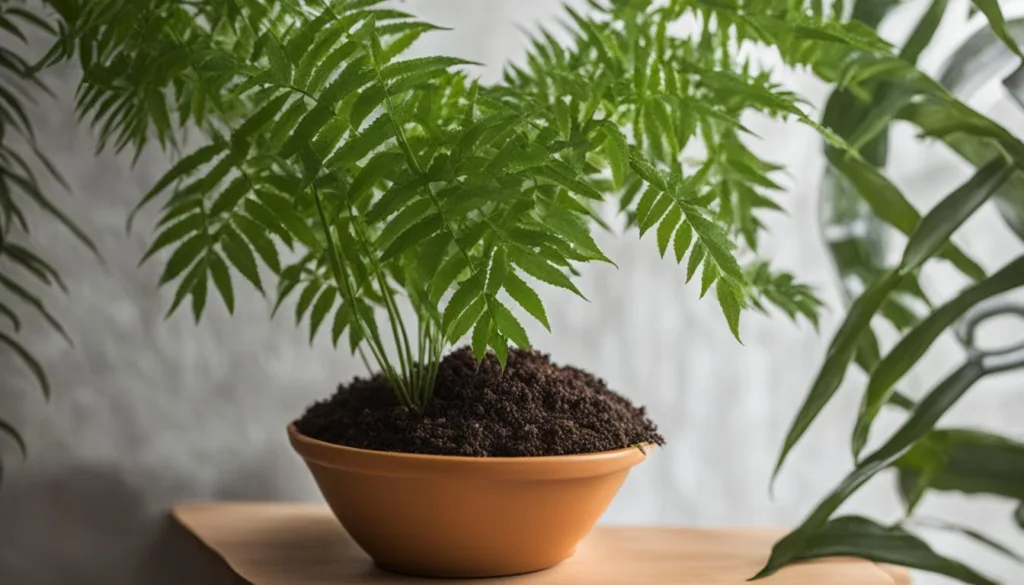
Indoor plants are susceptible to pest infestations, which can significantly impact their health and longevity. Implementing effective pest prevention and control measures is crucial to ensure the well-being of your indoor plants.
By regularly monitoring your plants, using organic methods, and taking prompt action when necessary, you can protect your plants from pests and promote their longevity.
Monitoring for Pests
Regular monitoring is essential to detect pest infestations at an early stage. Inspect your indoor plants regularly for signs of pests such as small insects, webs, or sticky residue on the leaves.
Pay close attention to the undersides of leaves and the soil surface. Additionally, monitor for any changes in plant appearance, such as wilting leaves, yellowing, or stunted growth, as these can indicate the presence of pests.
To facilitate monitoring, remove any fallen leaves or debris from around your plants, as these can provide hiding places for pests.
Keep your plants clean and free from dust, as this can also attract pests. Regularly wipe the leaves with a damp cloth to remove dust and ensure a healthy environment for your plants.
Organic Pest Control Methods
When it comes to pest control for indoor plants, organic methods are recommended to minimize the use of chemicals that can be harmful to the environment and your plants’ health.
Organic pest control involves the use of natural remedies and preventive measures to deter and eliminate pests.
Some effective organic pest control methods include:
- Using insecticidal soap or neem oil spray to control common pests like aphids, mealybugs, and spider mites. These natural solutions can suffocate and repel pests without harming your plants.
- Introducing beneficial insects, such as ladybugs or predatory mites, which feed on pests and help control their populations.
- Setting up sticky traps to catch flying pests like fungus gnats or whiteflies.
- Isolating infected plants to prevent the spread of pests to other plants.
Taking Prompt Action
If you notice the presence of pests on your indoor plants, it is essential to take immediate action to prevent further damage. Start by manually removing pests, such as picking off insects or wiping them away with a soft cloth. For severe infestations, consider using organic pest control methods mentioned earlier.
It is important to note that prevention is key when it comes to pests. By maintaining a clean and healthy environment for your indoor plants, regularly monitoring for pests, and implementing preventive measures, you can minimize the risk of infestations and promote the longevity of your plants.
Seasonal Adjustments for Indoor Plant Longevity
Indoor plants have different needs throughout the year, and making seasonal adjustments to your care routine is essential for promoting their longevity. Understanding the specific requirements of your plants during each season will help provide them with the optimal environment for growth and health.
During the winter months, indoor plants generally experience reduced growth and require less frequent watering.
As the temperature drops and the air becomes drier, it is important to monitor the moisture level of the soil and adjust your watering schedule accordingly. Overwatering can lead to root rot, so it is crucial to allow the soil to dry out between waterings.
Furthermore, indoor plants may benefit from increased humidity during the winter. You can provide extra humidity by using a room humidifier or placing a tray of water near your plants.
Grouping plants together can also help create a microclimate with higher humidity levels. However, be cautious not to place the plants too close together, as this can limit air circulation and promote the spread of pests or diseases.
| Seasonal Adjustments for Indoor Plant Care | Winter | Summer |
|---|---|---|
| Watering | Reduce watering frequency | Increase watering frequency |
| Humidity | Provide extra humidity | Monitor humidity levels |
| Lighting | Ensure adequate exposure to indirect sunlight | Protect from intense sunlight |
| Temperature | Avoid placing plants near cold drafts | Protect from extreme heat |
In contrast, during the summer months, indoor plants may require increased watering due to higher temperatures and increased evaporation.
It is important to monitor the moisture level of the soil and water your plants more frequently when the top inch of soil becomes dry. But, be careful not to overwater, as this can lead to root rot and other problems.
Additionally, summer brings intense sunlight that can be harmful to some indoor plants. Protect your plants from direct sunlight by placing them near windows with sheer curtains or providing them with shade.
Be mindful of the temperature as well and avoid placing plants near air conditioning vents or drafts that can cause rapid temperature fluctuations.
By adjusting your care routine to accommodate the changing seasons, you can ensure that your indoor plants thrive and enjoy long and healthy lives.
Observing and Responding to Plant Signals for Indoor Plant Longevity
As an indoor gardener, it’s important to pay attention to the signals your plants give you. Wilting leaves, yellowing, and stunted growth are all signs that something may be amiss in your plant’s environment or care routine.
By observing these signals and adjusting your approach, you can help ensure the longevity and well-being of your indoor plants.
Wilting leaves are often a sign that your plant isn’t receiving enough water. It’s important to strike a balance between underwatering and overwatering.
Check the moisture level of the soil regularly and water your plants when the top inch feels dry. Adjust the frequency and amount of watering based on your plant’s specific needs. Remember, different plants have different water requirements, so it’s essential to know your plant’s preferences.
Yellowing leaves can indicate various issues, including nutrient deficiencies, lack of sunlight, or even pest infestations. Assess the lighting conditions and adjust accordingly.
If your plant requires more sunlight, consider moving it to a brighter location or providing artificial light. It’s also important to fertilize your plants regularly with a balanced fertilizer to ensure they receive the necessary nutrients for healthy growth.
Common Plant Signals and Adjustments
| Plant Signal | Possible Cause | Adjustment |
|---|---|---|
| Wilting leaves | Underwatering | Increase watering frequency |
| Yellowing leaves | Nutrient deficiency or lack of sunlight | Adjust fertilization and lighting |
| Stunted growth | Lack of nutrients or inadequate lighting | Fertilize and provide proper lighting |
Stunted growth can be a result of insufficient nutrients or inadequate lighting. Ensure your plant is receiving the necessary nutrients through regular fertilization and adjust the lighting conditions as needed. If your plant requires more light, consider placing it near a window or using grow lights to supplement natural sunlight.
By staying vigilant and responsive to your plant’s signals, you can maintain a healthy and thriving indoor garden.
Remember to adjust your care routine based on the specific needs of each plant, and don’t hesitate to seek guidance from gardening resources or professionals if needed. With proper observation and adjustment, you can promote the longevity and vitality of your indoor plants.
The Joy of Indoor Gardening and its Benefits
Indoor gardening is not only a hobby but also a source of joy and numerous benefits. Engaging in indoor gardening allows me to create a thriving oasis within the comfort of my own home.
The presence of greenery and the act of nurturing plants bring a sense of tranquility and connection to nature. It is a delightful way to transform my living space into a relaxing and visually appealing environment.
One of the significant benefits of indoor gardening is its positive impact on stress reduction. Studies have shown that being surrounded by plants can help lower cortisol levels, a hormone associated with stress.
The act of caring for indoor plants, such as watering, pruning, and grooming, provides a sense of mindfulness and serves as a therapeutic activity. It allows me to unwind and find solace amidst the demands of daily life.
Indoor gardening also contributes to mood improvement. The presence of lush greenery and vibrant blooms creates a visually pleasing ambiance that uplifts the spirit. Being surrounded by nature has a calming effect on the mind and can improve overall well-being.
The act of nurturing plants and witnessing their growth and blooming stages evokes a sense of accomplishment and joy, boosting my mood and bringing a sense of fulfillment.
Furthermore, indoor gardening provides a space for relaxation and rejuvenation. Spending time in the company of plants has been proven to have a positive impact on mental health.
The act of tending to plants can serve as a form of meditation, allowing me to disconnect from the noise and distractions of the outside world. The peaceful environment created by indoor gardening promotes relaxation and helps restore inner balance.
The Benefits of Indoor Gardening:
- Stress reduction
- Mood improvement
- Relaxation and rejuvenation
Indoor gardening brings immense joy and enriches my living space with its beauty and positive energy. By surrounding myself with plants, I not only create a visually appealing environment but also enjoy the numerous benefits it offers.
Whether it’s reducing stress, improving mood, or finding solace in relaxation, indoor gardening enhances my overall well-being and adds a touch of nature to my life.
Caring for indoor plants is a fulfilling journey that requires attention and dedication. By following proper plant care guidelines, you can become a successful indoor gardener and promote the longevity of your plants. Remember, indoor plants thrive in a suitable environment that meets their specific needs.
To ensure your indoor plants’ health and longevity, pay attention to factors such as suitable lighting, proper watering, and adequate air circulation.
Regular pruning, grooming, and pest prevention measures are essential to maintain their well-being. Additionally, making seasonal adjustments to your care routine is crucial for their survival.
By observing and responding to your plants’ signals, such as wilting leaves or stunted growth, you can address issues promptly and provide the necessary care.
The benefits of indoor gardening extend beyond the plants themselves, as it brings stress reduction, mood improvement, and relaxation to your living space.
So, take joy in nurturing your indoor plants, knowing that you are creating a vibrant and thriving environment. As a successful indoor gardener, you have the power to extend the longevity of your plants through proper plant care and cultivation. Happy indoor gardening!
FAQ
What practices ensure the longevity of indoor plants?
Proper watering, adequate lighting, good ventilation, regular fertilization, suitable indoor locations, and regular pruning and grooming.
How often should I water my indoor plants?
Check the moisture level of the soil regularly and water the plants when the top inch of soil feels dry.
How can I increase the humidity for my indoor plants?
Increase humidity through methods like misting, using a humidifier, placing a tray of water near plants, or grouping plants together.
Where should I place my indoor plants?
Avoid placing plants near drafts, heating vents, or air conditioning units to prevent rapid temperature fluctuations.
How often should I fertilize my indoor plants?
Use a balanced, water-soluble fertilizer formulated for houseplants during the growing season and adjust fertilization during the dormant period.
Why is pruning and grooming important for indoor plants?
Pruning and grooming practices promote new growth, remove dead leaves, trim overgrown branches, and keep the plants healthy and vibrant.
How can I prevent pests from infesting my indoor plants?
Regular monitoring for pests and using organic methods like neem oil or insecticidal soap can help manage and prevent infestations.
How should I adjust my care routine for indoor plants during different seasons?
Make seasonal adjustments such as reducing watering during winter and providing extra humidity and protection from intense sunlight in summer.
What should I do if my indoor plants show signs of wilting or yellowing?
Promptly adjust your care routine or seek advice from gardening resources to address watering issues or nutrient deficiencies.
What are the benefits of indoor gardening?
Indoor gardening offers benefits like stress reduction, mood improvement, relaxation, and enhances the beauty and energy of your living space.
How can I become a successful indoor gardener?
By following proper plant care guidelines, observing and responding to your plant’s needs, and providing a suitable environment for their growth and well-being.

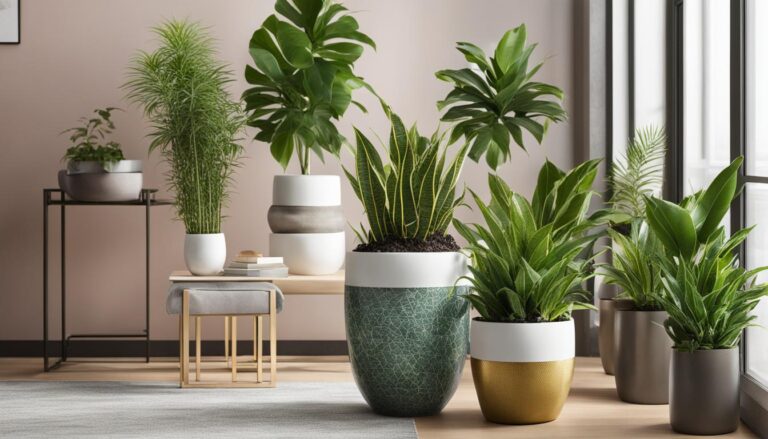
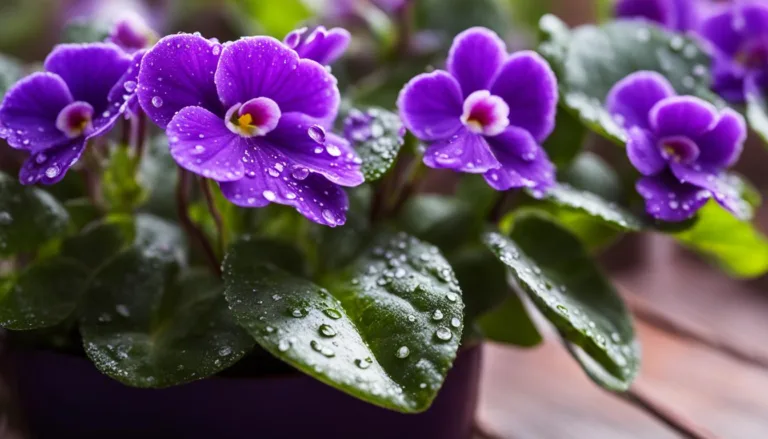
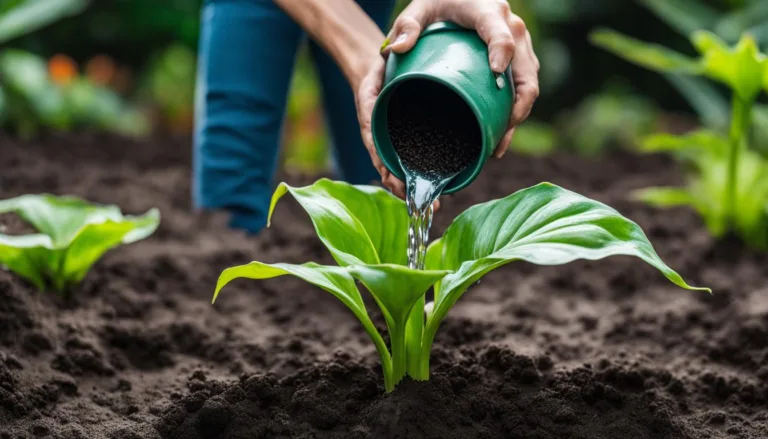
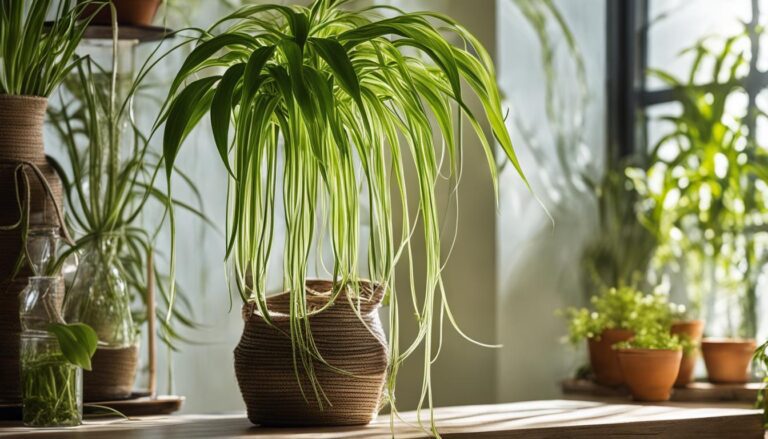
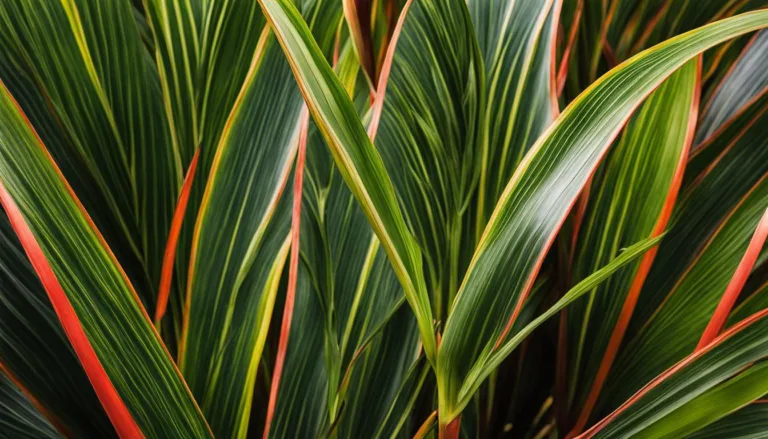
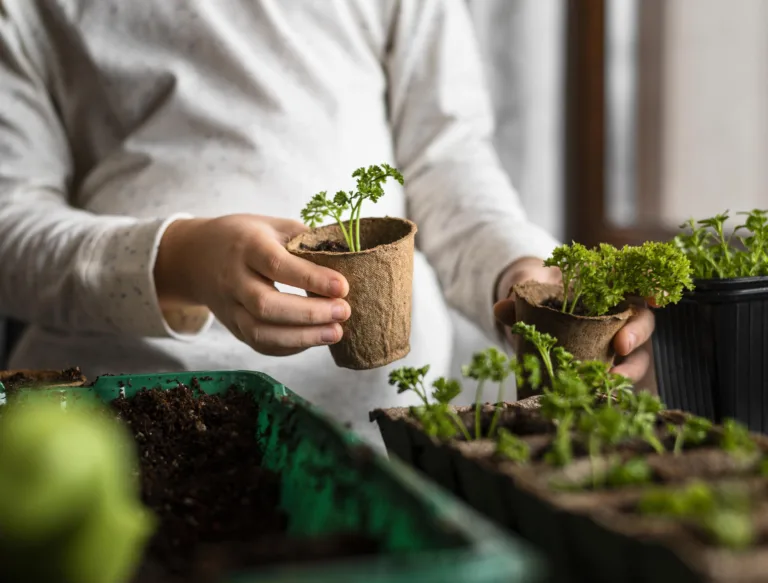
2 Comments